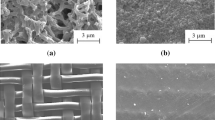Abstract
A novel method for the preparation of selective composite membranes from emulsions is suggested. The dispersed phase is chosen to yield a polymer soluble in those components for which the membrane should be selective; the continuous phase, on the other hand, is selected to yield a polymer that is insoluble in any of the components of the mixture. Conventional emulsions (which have a maximum dispersed phase volume fraction of 0.74) or microemulsions can be employed to generate composites. However, concentrated emulsions which allow volume fractions as large as 0.99 are most suitable as precursors to selective and efficient membranes. These concentrated emulsions have the appearance of gels with a structure similar to that of foams. The relatively high permeabilities obtained with the resultant membranes are due to the small thickness of the films of the continuous phase. A concentrated emulsion of a hydrophobic (hydrophilic) monomer dispersed in a hydrophilic (hydrophobic) continuous phase is first prepared at room temperature, with suitable initiators in each phase for later polymerization, and with an appropriate dispersant in the continuous phase. To ensure the stability of the emulsion, the hydrophilic monomer is, in general, replaced by monomer plus water. On heating the gel at 50 °C, polymerization occurs in both phases and the emulsion transforms into a composite polymer membrane. As examples, composite membranes containing polystyrene as the dispersed phase and polyacrylamide as the continuous phase are used to separate toluene from cyclohexane, while other composite membranes containing acrylamide as the dispersed phase and a crosslinked polystyrene as the continuous phase are used to separate water from ethanol.
Similar content being viewed by others
References
Prausnitz JM (1969) Molecular Thermodynamics of Fluid-Phase Equilibria. Prentice-Hall, Englewood Cliffs, New Jersey; Barton AFM (1983) CRC Handbook of Solubility Parameters and Other Cohesion Parameters
Lissant KJ (1966) J Colloid Interface Sci 22:492
Princen HM (1979) J Colloid Interface Sci 71:55
Ruckenstein E, Ebert G, Platz G (1989) J Colloid Interface Sci, in press
Ruckenstein E, Park JS (1988) J Polym Sci Lett 26:529
Park JS, Ruckenstein E (1989) J Appl Polym Sci 38:453 (PC1 and PC2 should be interchanged in the caption of Fig 8 of [6])
Huang RYM, Lin VJC (1968) J Appl Polym Sci 12:2615
Cabasso I, Jagur-Grodzinski J, Vofsi D (1974) J Appl Polym Sci 18:2137
Ruckenstein E, Park JS (1989) J Appl Polym Sci, in press
Heisler EG, Hunter AS, Siciliano RM, Treadway RM (1956) Science 124:77
Binning RC, Lee RJ (1960) US Patent 2953502
Aptel P, Cuny J, Jozefowicz J, Morel G, Neel J (1972) J Membrane Sci 16:1061
Tealdo GC, Canepa P, Munari S (1981) J Membrane Sci 9:191
Hirotsu T, Nakajima S (1988) J Appl Polym Sci 36:177
Author information
Authors and Affiliations
Rights and permissions
About this article
Cite this article
Ruckenstein, E. Emulsion pathways to composite polymeric membranes for separation processes. Colloid & Polymer Sci 267, 792–797 (1989). https://doi.org/10.1007/BF01410117
Received:
Accepted:
Issue Date:
DOI: https://doi.org/10.1007/BF01410117




